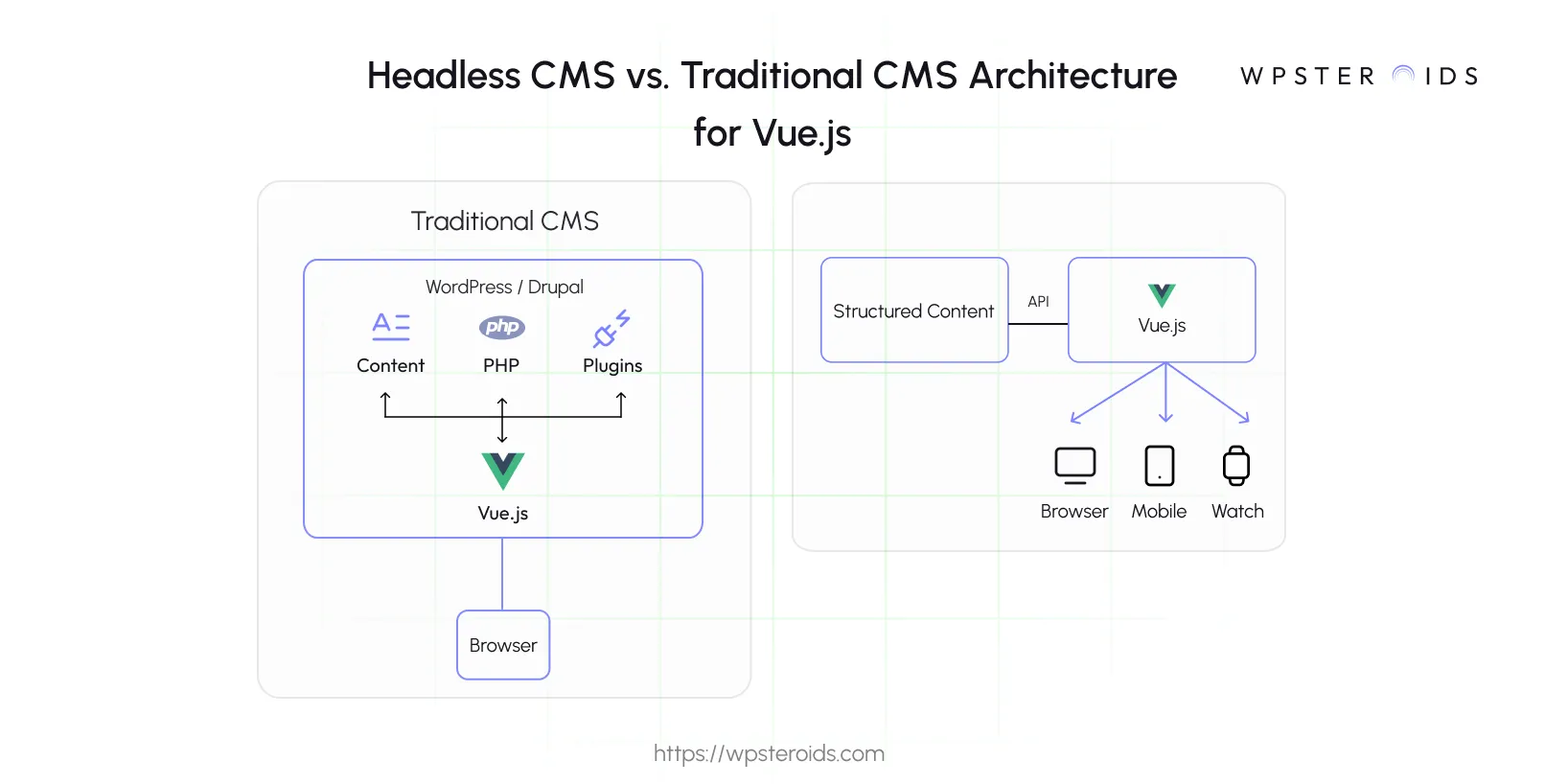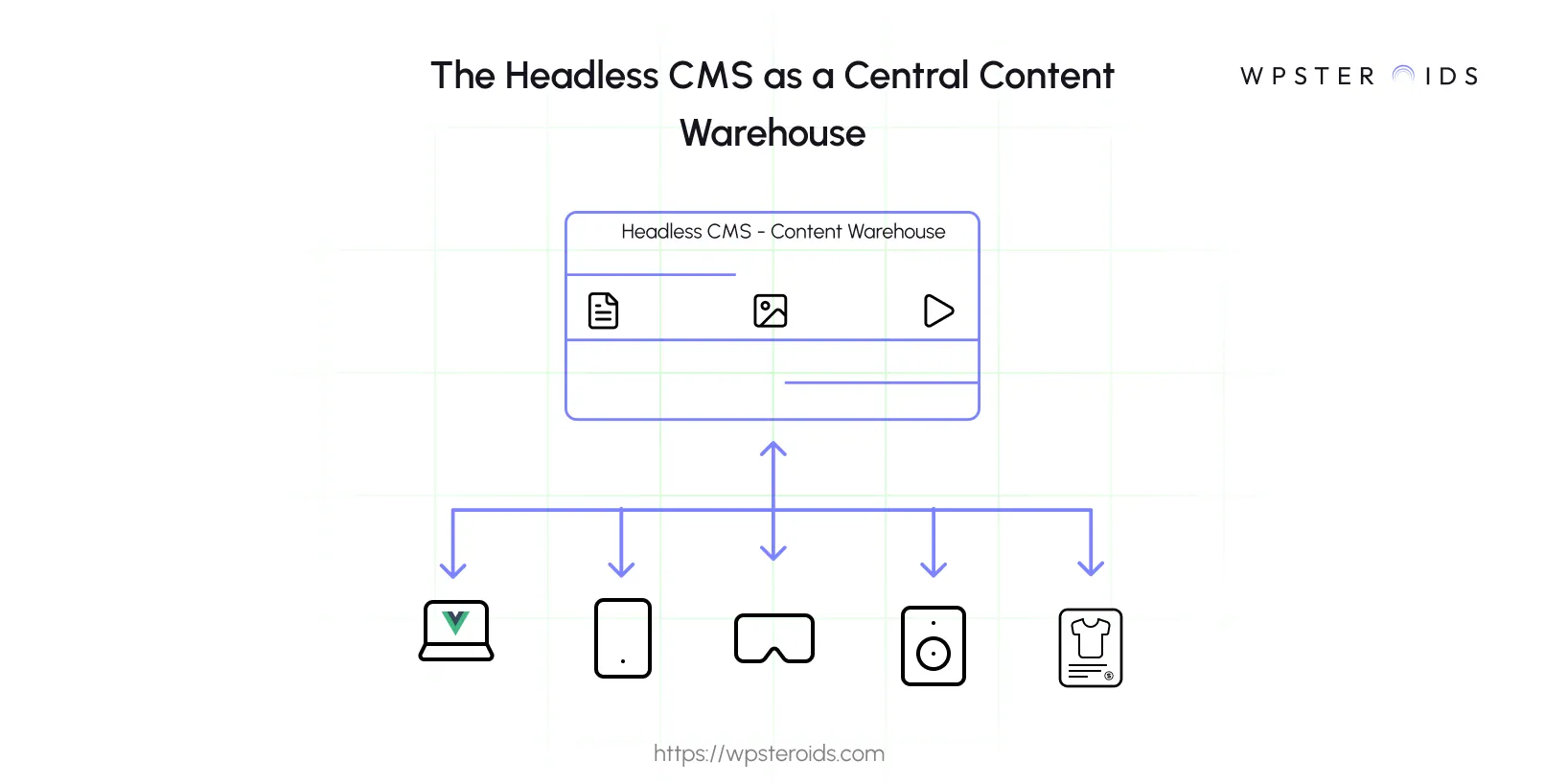
Headless CMS scales and improves WPWhiteBoard’s content distribution, flexibility, and personalization
Pruthvi Parade
Struggling to find a CMS that doesn’t bottleneck your Vue.js application?
You’ve invested in Vue for its speed and elegant component-based architecture, but the backend feels like an anchor, slowing down feature deployment and frustrating your engineers.
You're not just looking for a new tool; you're looking for a strategic shift that unlocks the full potential of your team and your tech stack, especially for demanding JS applications.
For most Vue.js projects, a headless CMS is the optimal choice. It decouples the content backend from the presentation layer, allowing developers to build fast, scalable, and secure front-ends that leverage Vue's full capabilities.
This guide provides a strategic framework for choosing the right VueJS CMS for your specific needs. We will move beyond simple feature lists to give you a clear-eyed perspective on what truly matters.
By the end, you won't just have a list of options; you'll have a repeatable process for choosing the right CMS.
That model worked for a simpler web, but for today's demanding applications, it is a significant liability.
Traditional, or monolithic, CMS platforms were built for a page-based world. They force a tight coupling between the backend database and the front-end template.
This creates several problems for a modern Vue.js workflow:
These platforms were not designed for an API-first world. Retrofitting them for your Vue stack often feels like trying to fit a square peg in a round hole.

To truly grasp the strategic advantage a headless CMS offers, it helps to stop thinking about websites and start thinking about content logistics.
Imagine a traditional CMS is like a department store mannequin. The content (the clothes), the presentation (the mannequin's pose), and the channel (the store window) are all tightly coupled.
You cannot easily take those clothes and put them in a mail-order catalog or a mobile app.
Now, picture a headless CMS as a central warehouse. Your content—articles, product descriptions, images—is neatly stored and organized as pure, structured content.
The warehouse manager (the API) does not care how you are going to display the items. You simply send a request: "I need three blog posts and an author bio". The manager sends you just the raw JSON data.
Now, your developers can render that data into any component you want: a website view, a mobile app screen, or even a voice assistant's script.
This fundamental separation of content from the presentation layer is what a headless CMS solves so elegantly. This CMS separation content model is the future.

Here’s a quick breakdown of how the two approaches stack up:
| Feature | Traditional CMS (e.g., WordPress) | Headless CMS (e.g., Directus, Strapi) |
|---|---|---|
| Flexibility | Limited by themes and plugins. The front-end and backend are tightly coupled. | Total freedom. Use any front-end framework (like Vue) and content design you want. |
| Performance | Slower, as the server renders the entire page, including presentation logic. | Significantly faster. The front-end fetches raw data and renders it client-side. |
| Security | Larger attack surface due to the coupled front-end and plugin ecosystem. | More secure. The content backend is separate from the presentation layer, accessible only via API. |
| Scalability | Scaling can be complex and expensive, requiring whole-server replication. | Easier to scale. The front-end and backend scale independently based on demand. |
The workflow is straightforward and developer-centric. Your marketing and content teams use a clean, web-based interface for building content. The headless CMS then takes that content and makes it available through secure content APIs.
Your Vue developers can then make simple API calls from your application to fetch this content. The CMS delivers pure, unformatted data (usually in JSON format), which your Vue components can then display however you see fit.

You get all the power of a world-class content management backend without sacrificing any control or performance on the front-end.
Choosing a headless architecture isn't just a technical preference; it's a strategic business decision that unlocks significant advantages for any JS project.
Application speed is non-negotiable. A traditional CMS forces your Vue app to wait on a slow, monolithic backend. A headless approach completely flips the script.
By decoupling the two, you allow your Vue.js front-end to operate as a standalone application. It fetches lightweight JSON data from the CMS API and renders the content on the client side.
Your Vue.js website is just one touchpoint. What about your mobile app, a partner portal, or an AI chatbot that needs to access your knowledge base?
This is where a JS headless cms excels.
With a headless CMS, your content is stored as pure, structured data, ready for API-first content delivery. This means you can write it once and deliver it everywhere.
This approach makes scaling content across platforms effortless and ensures that as new channels emerge, you’re already prepared to meet your audience there.
Your development team is one of your most valuable resources. Clunky, restrictive systems are a primary source of frustration.
A headless CMS implementation directly addresses this need.
It creates a clear separation of concerns that streamlines development workflows js. Your front-end developers can focus entirely on building beautiful, efficient Vue components without ever needing to touch the backend.
Meanwhile, your content team can work independently.
This parallel workflow eliminates bottlenecks and helps you ship features faster and with higher quality.
Any headless CMS with a decent API can send data to a Vue.js application. That’s the baseline. But if you stop there, you’re missing the most profound opportunity for synergy.
The conversation should not be about whether you can fetch data into Vue, but whether you can use your team's existing Vue.js skills to customize and extend the CMS admin panel itself.
This is the most critical, yet overlooked, evaluation metric for a cms with Vue.
Think about it. Can you build custom input components, data visualizations, and bespoke editorial workflows using Vue?
When your developers can use their favorite framework to build custom Vue components inside the CMS, it enables developers to create a unified and powerful platform.
Beyond extensibility, a set of core key features is non-negotiable for ensuring a smooth Vue integration. As you evaluate your options, treat this as your essential checklist:
When you decouple your front-end from your backend, you also shift your security perimeter.
Your API is no longer a private backend endpoint; it becomes the public-facing gateway to all your content. Protecting this gateway is a foundational pillar of your application's architecture.
For example:
Implementing proper role based access control enforces the principle of least privilege, a must-have for any team that is scaling.
Beyond managing your internal team, you need to protect your content from unauthorized external access.
This is where enterprise-grade security features become non-negotiable.
Look for a CMS that provides:
The pairing of vue js with a headless cms creates a symbiotic relationship where each part enhances the other.
It's a strategic architectural choice that aligns perfectly with the demands of modern web development, especially Vue applications.
When you bring them together, you create a perfect separation of concerns:
Ultimately, this combination allows you to build faster, more secure, and more scalable digital experiences.
Which vue headless cms is the right one for your project? The answer depends on your application needs and team priorities.
Strapi is the leading open-source, self-hosted headless CMS. Its primary strengths are its flexibility and customizability. You host it on your own infrastructure, giving you complete control over your data and environments JS.
Contentful is a SaaS powerhouse designed for enterprise-level scale and governance. A cms known for its reliability, it allows for integration with hundreds of other tools.
Sanity stands out with its developer-centric approach. It treats your content as data. Its standout feature is the Sanity Studio, a highly customizable, open-source editing environment built with React that offers real-time collaboration.
Storyblok’s killer feature is its visual editor, which provides a real-time preview of your Vue.js website as you edit. It bridges the gap between the flexibility of headless and the user-friendliness of a traditional page builder.
There is no single "best" headless cms for Vue. The perfect choice is the one that best aligns with your team's skills, your project's technical requirements, and your business goals.
To help, ask your team these three critical questions:
By working through these questions, you can effectively map your requirements to the unique strengths of each CMS.
You started this journey looking for a content management system that could keep up with your Vue application.
The right solution is a modern architectural approach that unlocks performance, agility, and scale.
For any team serious about building Vue applications today, a headless cms is the superior architectural choice.
As you move forward, remember that success will hinge on three core pillars:
Selecting the right headless cms vue is a foundational decision that will power your content and drive your digital experiences forward.
Ready to connect your Vue.js application to a powerful, secure, and scalable content backend? Book your discovery call.
What is the best headless CMS for Vue 3 and Vite?
What is a recommended Vue 3 tech stack with a headless CMS in 2025?
A powerful, forward-looking stack for 2025 would be:
What is the best database to use with Vue?
This is a common point of confusion. Vue.js is a front-end framework; it runs in the user's browser and does not connect directly to a database. A headless CMS acts as the intermediary. The database choice is determined by the headless cms, not by Vue itself.
Is there a headless CMS built on Vue.js?
Yes. Directus stands out because its entire admin interface is an open-source application built with Vue.js. This is a significant advantage for development teams with Vue expertise, as it integrates seamlessly with vue.
Does Vue.js have its own CMS?
No, Vue.js is a progressive JavaScript framework for building user interfaces. It is an open-source project and does not have an official or built-in CMS. Its design allows for a flexible integration with Vue and any API.
Is Directus a good CMS for Vue.js?
Yes, Directus is an excellent CMS for Vue.js projects. Because its data studio is built with Vue, it offers a level of synergy that is unmatched. It provides a clean API that delivers pure content data, giving your Vue developers complete freedom on the front-end. This makes it a top-tier choice for teams wanting a highly customized headless cms with Vue.
How do I choose the right CMS for my Vue.js project?
To choose the right cms for Vue, focus on three key areas:
Which CMS is best for SEO with Vue.js?
SEO success with Vue.js primarily depends on your front-end architecture, specifically using Server-Side Rendering (SSR) or Static Site Generation (SSG) via a framework like Nuxt. The best headless cms for Vue in this regard is one that gives you full control over all SEO-related metadata. Any top-tier Vue-compatible headless cms like Contentful, Sanity, or Directus excels here.
